Nick Malceski, with just 34 seconds left, about to clinch the 2012 flag in one of the greatest grand finals. Photo: AFL MEDIA
What makes a truly great grand final? Which factors should be considered the most important to that subjective judgement?
Is it the actual quality of the football played? Is it the closeness of the scores? Is it individual performances? Is it moments of high drama? Is it a gripping storyline? You’re lucky to get all those elements combining in any old match, let alone the most important of the year.
I think most people would have close scores at the top of the tree of importance, given the stakes involved.
Take Brisbane’s 2002 nine-point win over Collingwood for example. Sure, it wasn’t necessarily the highest quality of football in wet, greasy conditions. But a game always in doubt until the final seconds was a welcome change from a couple of decades in the 1980s and ‘90s when lopsided blowouts became far more the norm than the exception.
Indeed, that was only the second grand final in the previous 23 to be decided by a single-figure margin. But since then, we’ve been relatively spoiled.
Sure, Geelong’s obliteration of Port Adelaide in 2007 set a new record margin of 119 points, and Richmond in 2019 smacked up GWS by 89, now the third-biggest winning margin in grand final history.
But we’ve also seen five decided by 12 points or less and another in which two teams couldn’t be separated, Collingwood and St Kilda’s 2010 draw the last of three in league history following a rule introducing extra time for similar circumstances.
Most tight games are going to deliver in the area of drama, Dom Sheed’s matchwinner for West Coast against Collingwood with just one minute 40 seconds left on the clock three years ago the most obvious example.
PLEASE HELP US CONTINUE TO THRIVE BY BECOMING AN OFFICIAL FOOTYOLOGY PATRON. JUST CLICK THIS LINK.
Individual performances? Interestingly, two of the very best I’ve witnessed on the grand final stage came in losing efforts, Gary Ablett senior’s nine goals in the 1989 epic, and Dermott Brereton’s eight-goal in Hawthorn’s 1985 thrashing at the hands of Essendon.
Storylines? Pretty hard to beat the Western Bulldogs’ effort in 2016, Collingwood’s drought-breaker in 1990, or the Swans first’ flag since 1933 in their 2005 nail-biter against West Coast.
So the best? I’ve decided for the purposes of this exercise to stick to those I have actually attended. Fortunately for me, that’s every one from 1973 until 2019, Covid having left me stranded on 49 (including two replays), one short of the half-century.
Had it been any I had seen in its entirety, including TV replays, I would have the epic 1970 battle of Carlton and Collingwood an undisputed No.1, with St Kilda’s famous 1966 one-point triumph ranking highly, ditto the last meeting of Richmond and Geelong on the big day in 1967.
Of course, that’s grossly unfair to the 60-odd played before the advent of television, but you can’t judge what you can’t see.
There’s plenty of apologies, too. Even to one of those three draws, which got squeezed out only by another even more recent classic. Ditto the two Sydney-West Coast thrillers of 2005-06. That Brisbane-Collingwood game I mentioned earlier. And a very underrated ripper in 2011 between the Pies and Cats, only because of a late blowout on the scoreboard.
I’m sure everyone has their own lists, and most will take issue with at least one entry on mine. But that’s half the fun. So without further ado, here are the best five grand finals I have witnessed in the flesh.
No.1 – 2012: SYDNEY v HAWTHORN
For sheer quality of football, a see-sawing game and a thrilling finish, Sydney’s 10-point win over the Hawks remains the best I’ve seen. It’s the only grand final to feature not just one comeback, but three, Hawthorn in charge early, the Swans striking back, the Hawks surging again and appearing to have it won before one more dramatic twist. Sydney had peeled off eight unanswered goals to lead by 28 points midway through the third term before the Hawks in a spectacular burst slammed on five in just 10 minutes. They looked home after Luke Breust and David Hale goaled early in the last. But the Swans came again. Dan Hannebery drew them closer, Kieren Jack levelled the scores after the Hawks’ Clinton Young slipped in the goalsquare. With Adam Goodes on one leg, the Swans continued to attack, the veteran’s solo effort giving them the lead before Nick Malceski’s unforgettable snap for the sealer with only 34 seconds left on the clock. An epic.
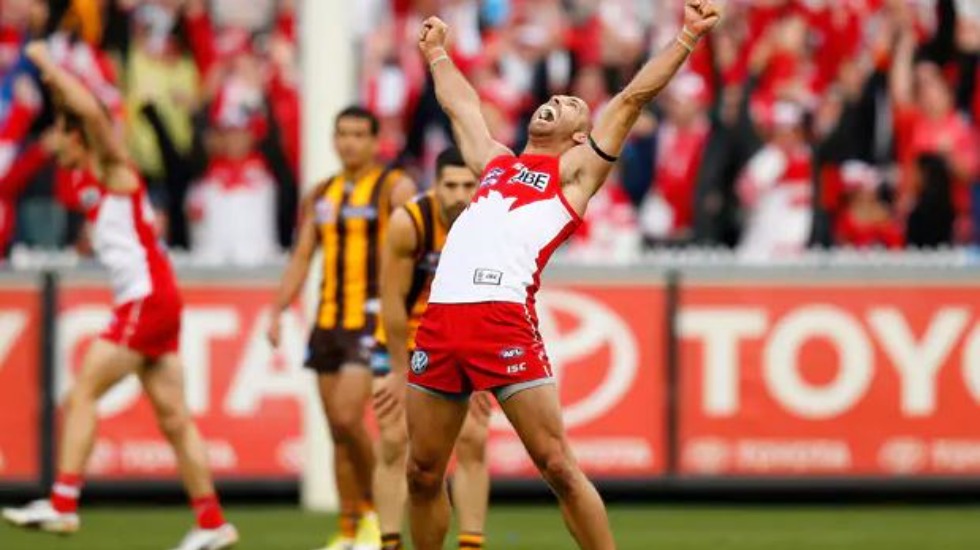
Sydney skipper Jarrad McVeigh celebrates the final siren to give the Swans a 10-point win in 2012. Photo: AFL MEDIA
No. 2 – 2018: WEST COAST v COLLINGWOOD
So, so close to No.1 for many reasons. Dom Sheed’s ice-cool kick from hard up against the boundary to give the Eagles the lead for the final time with only 100 seconds of play remaining was the latest match-winning goal since Fred Stafford had given Carlton a one-point win over Essendon in 1947. The 29-point deficit late in the first term West Coast chased down was the largest overcome since the Bombers of 1984. Collingwood led for all but nine minutes of the match, but spent much of the second half clinging on as the Eagles squandered opportunities. The Pies kicked again at the start of the last term with two goals in under two minutes. Still West Coast came, finally hitting the lead after one of the greatest passages of play grand finals have seen, a terrific intercept mark to Jeremy McGovern, a spearing pass to Nathan Vardy, another huge leap from Liam Ryan, then Sheed’s composed finish. Even then, there was drama, Jack Darling dropping a sitter of a chest mark which would have sealed the deal. The Eagles prevailed anyway, though, in a truly outstanding contest, and unfortunately for Collingwood, another dose of grand final heartache.

Jubilation for West Coast, despair for Collingwood as the siren sounds on 2018. Photo: AFL MEDIA
No. 3 – 1989: HAWTHORN v GEELONG
This was a game in which for the vast bulk one team led by six or seven goals, but ’89 is a bona fide classic for a number of reasons, the seasoned pros the Hawks up against the precocious, all-guns-blazing Cats. It had courage in Dermott Brereton’s KO at the first bounce then recovery to kick an inspiring goal, and an amazing individual performance from Gary Ablett, who equalled the grand final record with nine goals. It had brilliant end-to-end attacking and high-scoring, a 42-goal game the second highest aggregate in history. And it had bravery as a whole by the Hawks as they lost a succession of players injured, hanging on desperately by six points at the finish as Geelong piled on eight goals in the final term. No other grand final has been both as tough and at the same time as free-flowing as was the 1989 classic.
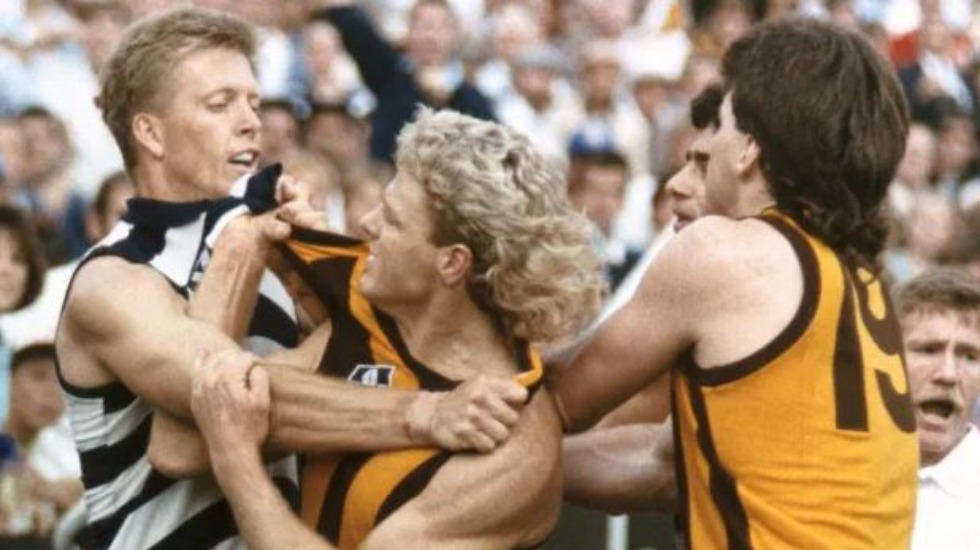
Geelong’s Steve Hocking and Hawk champion Dermott Brereton come to grips in the brutal grand final of 1989. Photo: THE AGE
No. 4 – 1984: ESSENDON v HAWTHORN
Hawthorn had beaten Essendon three times in 1984, and early in the second quarter on grand final day, appeared every chance not only of a fourth, but of repeating their record 83-point smashing of the Dons the year before. Gradually, Essendon, with coach Kevin Sheedy throwing the chess pieces all over the board, began to regain its composure, but even at three-quarter time, still 23 points in arrears, victory looked a long shot. But having kicked just five goals to the last change, Essendon washed away 19 years of flagless frustration in a hailstorm of goals, the biggest comeback from a three-quarter time deficit in grand final history. Leon Baker lit the spark, and his second goal of the last quarter and fourth for the game, following a sublime blind turn, gave the Dons the lead for the first time. Hawthorn regained the lead, but Essendon surged again, adding another five goals in time-on for a then record final term 9.6, the largely pro-Essendon crowd roaring in appreciation.
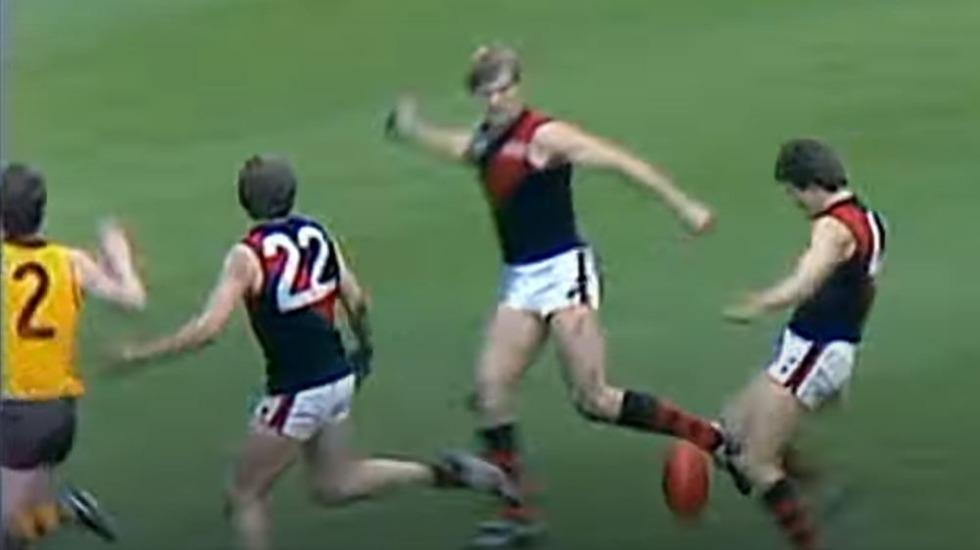
Essendon’s Leon Baker, about to kick his fourth goal to give the Bombers the lead for the first time. Picture: CHANNEL 7
No.5 – 1977: NORTH MELBOURNE v COLLINGWOOD
The “Colliwobbles” were the stuff of football legend by 1977, but at three-quarter time on grand final day they were about to become history, the Pies set to break a 19-year premiership drought, leading North by 27 points, the Roos having been held to just four goals, Len Thompson dominant in the ruck and Peter Moore with four goals. Suddenly, though, North got a sniff. Darryl Sutton started the comeback, skipper David Dench pounced on an errant Phil Manassa handball for another, and Phil Baker began plucking them from the air. When Baker booted his sixth, the Roos led by seven points. But one last attack, a mark to Ross “Twiggy” Dunne in the middle of a huge pack, and suddenly we had our second grand final draw. Like the other 100,000-odd people there, this 12-year-old sat stunned for several minutes as the players collapsed on the ground, knowing they’d have to do it all again. Why this draw and not 2010? One reason. A bigger comeback and even later in the game.

North Melbourne full-forward Phil Baker, who finished with six goals, flies high over the pack in the drawn 1977 grand final.

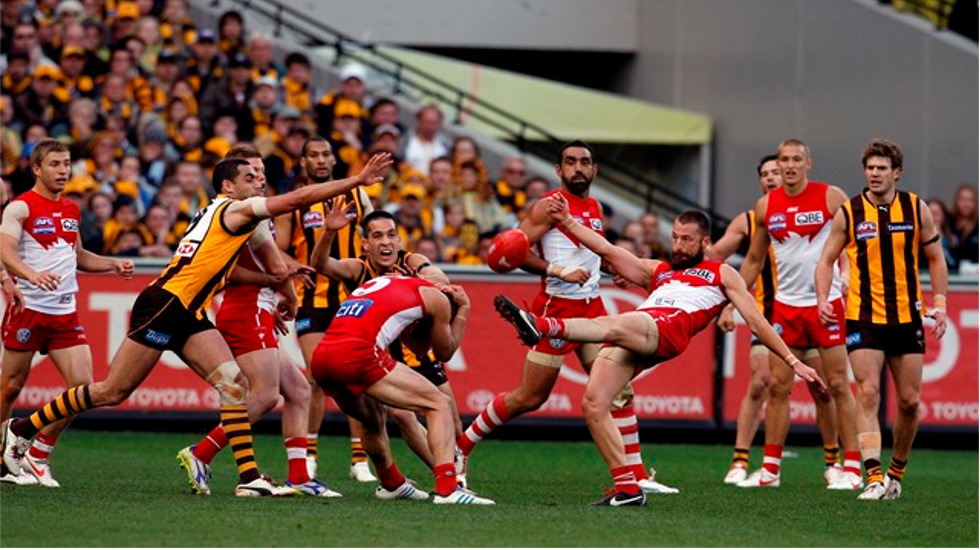
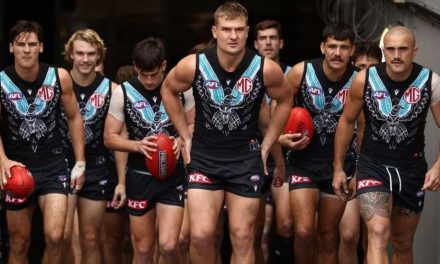

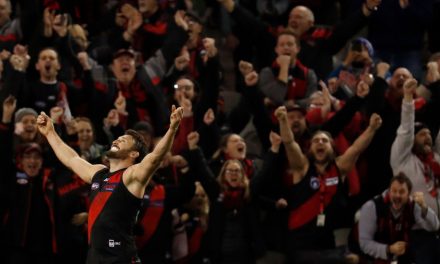
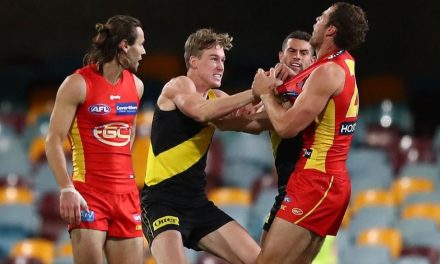






In 1984 I had been standing under the old Southern Stand, freezing for 5 hours (that was the deal with standing room tickets, first in best dressed) only to get to three quarter time of the GF and my beloved Dons were staring down the barrel of consecutive humiliations at the hands of Hawthorn. There was an old guy who had been standing next to me throughout that day, must have been in his 70s who turned to me at three quarter time and said “well that’s it for me mate, I’m done. Not going to stand here and watch us get smashed again!!” He handed me his old tatty Bomber’s scarf and left. I honestly pray that he never saw the final score.
I wouldn’t disagree with the choices or the well-put reasoning, but I’d like to add a word in defence of a proper, professional strangulation or massacre. Like Richmond 1973, the Brisbane treble, Port 2004 or Richmond 2019. Or this year’s prelims.
I don’t mean beating up on a seriously wounded or exhausted opponent. I mean the professional achievement of being so well prepared and motivated against a good opponent that – like the Viv Richards story – “pick whoever you want, man, it’s not going to make any difference”. We’re inside your heads, our game plan is better than yours, and if you’re interested we’re better at your game plan than you are. Notify your next of kin.
Some days, we’re the kid in the backyard winning our imaginary grand final with the big kick after the siren. Some days, we’re the kid for whom magic happens and everything we do is a winner. For so many things, our grown up selves expect life to be a hard, imperfect but hopeful slog – but I think One Perfect Day is the dream we dream in technicolour.
Does Amon Buchanan’s goal in 2005 not count as a winning goal